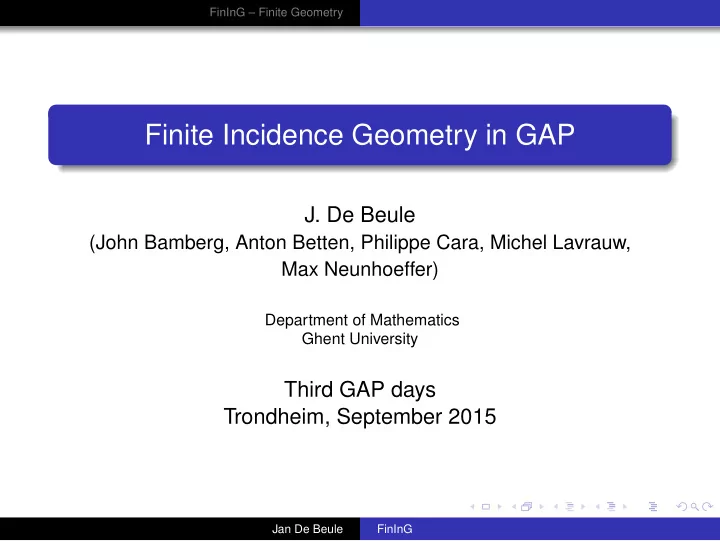

FinInG – Finite Geometry Finite Incidence Geometry in GAP J. De Beule (John Bamberg, Anton Betten, Philippe Cara, Michel Lavrauw, Max Neunhoeffer) Department of Mathematics Ghent University Third GAP days Trondheim, September 2015 ruglogo Jan De Beule FinInG
FinInG – Finite Geometry Incidence geometry Synthetic viewpoint: points, lines, circles, etc. are abstract objects; there is an incidence relation between these objects; satisfying axioms. Finite geometry: extra assumption that the number of objects is finite. ruglogo Jan De Beule FinInG
FinInG – Finite Geometry Incidence geometry An automorphism of an incidence geometry is a type preserving map respecting the incidence relation. Interaction between groups and geometries is actually the birth of the field. Representing incidence geometries as group coset geometries is one possibility. Projective planes are coordinatised over an algebraic structure. Representing incidence geometries in an analytic way is another possibility. ruglogo Jan De Beule FinInG
FinInG – Finite Geometry Incidence geometry An automorphism of an incidence geometry is a type preserving map respecting the incidence relation. Interaction between groups and geometries is actually the birth of the field. Representing incidence geometries as group coset geometries is one possibility. Projective planes are coordinatised over an algebraic structure. Representing incidence geometries in an analytic way is another possibility. ruglogo Jan De Beule FinInG
FinInG – Finite Geometry Philiosophy of doing incidence geometry in GAP We want the user to be able to explore geometries and their substructures Integrated with with existing (group theoretical) functions of GAP Ease of use has priority above super performance ruglogo Jan De Beule FinInG
FinInG – Finite Geometry Philiosophy of doing incidence geometry in GAP We want the user to be able to explore geometries and their substructures Integrated with with existing (group theoretical) functions of GAP Ease of use has priority above super performance ruglogo Jan De Beule FinInG
FinInG – Finite Geometry Philiosophy of doing incidence geometry in GAP We want the user to be able to explore geometries and their substructures Integrated with with existing (group theoretical) functions of GAP Ease of use has priority above super performance ruglogo Jan De Beule FinInG
FinInG – Finite Geometry FinInG history 1999: pg : predecessor of FinInG (JDB, Patrick Govaerts and Leo Storme). 2006: John Bamberg, Anton Betten, Philippe Cara, Michel Lavrauw, and Max Neunhoeffer join. ruglogo Jan De Beule FinInG
FinInG – Finite Geometry Some examples (including collineation groups) Projective spaces over finite fields. Finite classical polar spaces. ruglogo Jan De Beule FinInG
FinInG – Finite Geometry Some examples (including collineation groups) Projective spaces over finite fields. Finite classical polar spaces. ruglogo Jan De Beule FinInG
FinInG – Finite Geometry Semi-linear maps on vector spaces A collineation of a projective space is a semi-linear map of the underlying vector space These objects are implemented in fining, including there action on subspaces and nice monomorphisms. Functions based on orb and genss packages provide efficient ways of computing orbits and stabilizers directly. ruglogo Jan De Beule FinInG
FinInG – Finite Geometry Semi-linear maps on vector spaces A collineation of a projective space is a semi-linear map of the underlying vector space These objects are implemented in fining, including there action on subspaces and nice monomorphisms. Functions based on orb and genss packages provide efficient ways of computing orbits and stabilizers directly. ruglogo Jan De Beule FinInG
FinInG – Finite Geometry A group coset geometry ruglogo Jan De Beule FinInG
FinInG – Finite Geometry Overview of FinInG Projective spaces, classical polar spaces, affine spaces, generalized polygons, coset geometries and diagrams. Algebraic varieties Integration of all the different parts: collineation groups and group actions, geometry morphisms, stabilizer groups of elements and sets of elements, efficient enumerators for elements, etc. manual of ± 250 pages (including 288 examples), ± 50 pages of additional technical documentation ruglogo Jan De Beule FinInG
FinInG – Finite Geometry Overview of FinInG Projective spaces, classical polar spaces, affine spaces, generalized polygons, coset geometries and diagrams. Algebraic varieties Integration of all the different parts: collineation groups and group actions, geometry morphisms, stabilizer groups of elements and sets of elements, efficient enumerators for elements, etc. manual of ± 250 pages (including 288 examples), ± 50 pages of additional technical documentation ruglogo Jan De Beule FinInG
FinInG – Finite Geometry Overview of FinInG Projective spaces, classical polar spaces, affine spaces, generalized polygons, coset geometries and diagrams. Algebraic varieties Integration of all the different parts: collineation groups and group actions, geometry morphisms, stabilizer groups of elements and sets of elements, efficient enumerators for elements, etc. manual of ± 250 pages (including 288 examples), ± 50 pages of additional technical documentation ruglogo Jan De Beule FinInG
FinInG – Finite Geometry Overview of FinInG Projective spaces, classical polar spaces, affine spaces, generalized polygons, coset geometries and diagrams. Algebraic varieties Integration of all the different parts: collineation groups and group actions, geometry morphisms, stabilizer groups of elements and sets of elements, efficient enumerators for elements, etc. manual of ± 250 pages (including 288 examples), ± 50 pages of additional technical documentation ruglogo Jan De Beule FinInG
FinInG – Finite Geometry Dependencies forms (John Bamberg and JDB) grape (Leonard Soicher) orb (Juergen Mueller, Max Neunhoeffer, Felix Noeske, M. Horn) genss (Max Neunhoeffer, Felix Noeske, M. Horn) cvec (Max Neunhoeffer, M. Horn) ruglogo Jan De Beule FinInG
FinInG – Finite Geometry How to get http://cage.ugent.be/fining ruglogo Jan De Beule FinInG
Recommend
More recommend